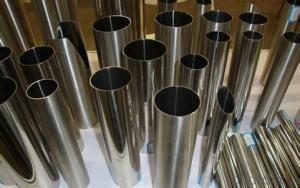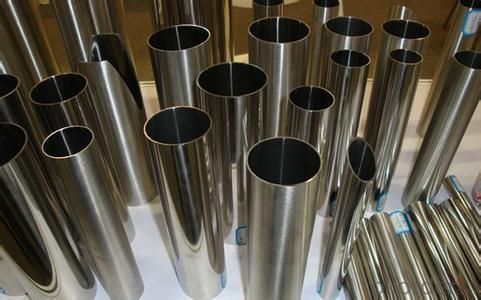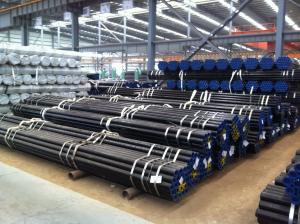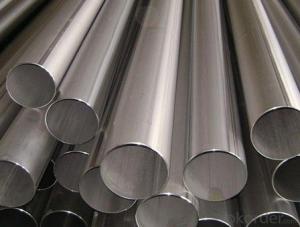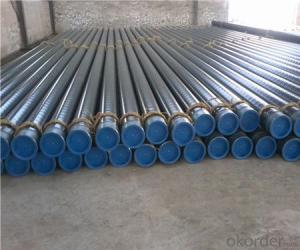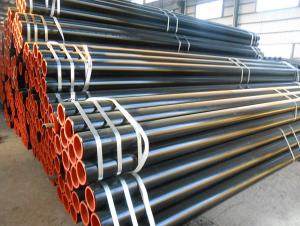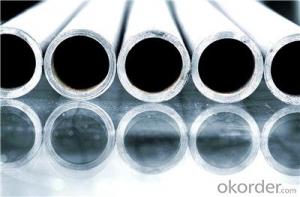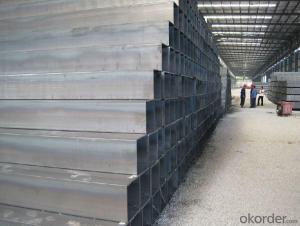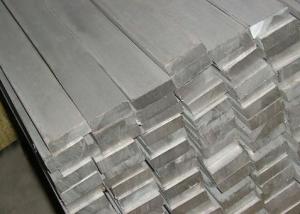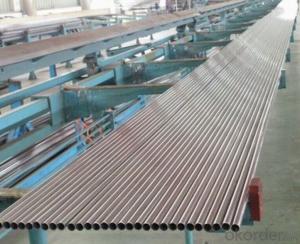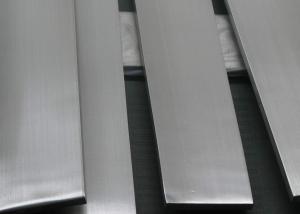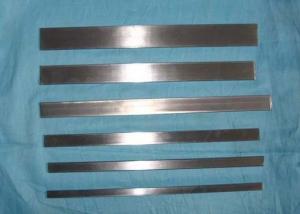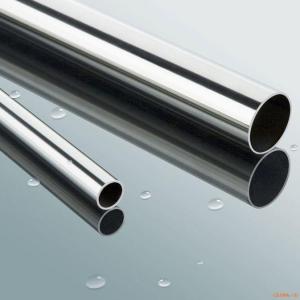ASME API 5L High Quality Stainless Steel Pipe
- Loading Port:
- Tianjin
- Payment Terms:
- TT or LC
- Min Order Qty:
- 25 m.t.
- Supply Capability:
- 10000 m.t./month
OKorder Service Pledge
OKorder Financial Service
You Might Also Like
We are company that have many years experience and professional manager team and engineer team and sales team, sure we will provide you high quality of pipe and professioanl service.
Seamless pipe possesses a hollow section and without seam around the strip steel. It is made with solid bar or steel ingot by perforating machine. As the facture process does not include any welding, seamless pipes are considered to be stronger and more durable. Generally speaking, seamless pipe has better pressure resistance and security than other classifications, and was usually more easily available than welded pipe.
2、Main Features of the Seamless Pipe:
• High working accuracy
• High strength
• Small inertia resistance
• Strong therming dissipine ability
• Good appearance
• Reasonble price
3、Seamless Pipe Specification:
Standard | GB, DIN, ASTM ASTM A106-2006, ASTM A53-2007 |
Grade | 10#-45#, 16Mn 10#, 20#, 45#, 16Mn |
Thickness | 8 - 33 mm |
Section Shape | Round |
Outer Diameter | 133 - 219 mm |
Place of Origin | Shandong, China (Mainland) |
Secondary Or Not | Non-secondary |
Application | Hydraulic Pipe |
Technique | Cold Drawn |
Certification | API |
Surface Treatment | factory state or painted black |
Special Pipe | API Pipe |
Alloy Or Not | Non-alloy |
Length | 5-12M |
Outer Diameter | 21.3-610mm |
Grade | 20#, 45#, Q345, API J55, API K55, API L80, API N80, API P110, A53B |
Standard | ASME, ASTM |
1) Material:20#(ASTM A 106/A53 GRB.API5LGRB,GB),45#,16Mn,10#.
2) Specification range: OD: 21.3-610mm, WT:6-70mm, length:6-12m or according to the requirement of clients.
3) Executive standards: GB, ASME API5L.ASTM A 106/A53,Despite of the above standards, we can also supply seamless steel pipe with standard of DIN, JIS, and so on, and also develop new products according to the requirements of our clients!
4) Surface: black lacquered, varnish coating or galvanized.
5) Ends: Beveled or square cut, plastic capped, painted.
6) Packing: bundles wrapped with strong steel strip, seaworthy packing.
4、Packaging & Delivery:
Packaging Details: | seaworthy package, bundles wrapped with strong steel strip |
Delivery Detail: | 15-30days after received 30%TT |
5、FAQ of Seamless Pipe:
①How is the quality of your products?
We have many years business experience in this area, and we have professional engineer and manager team and sure we can provide you high quality production and professional service.
②How about price?
Yes, we are factory and be able to give you lowest price below market one, and we have a policy that “ for saving time and absolutely honest business attitude, we quote as lowest as possible for any customer, and discount can be given according to quantity”,if you like bargain and factory price is not low enough as you think, just don’t waste your time.Please trust the quotation we would give you, it is professional one.
③Why should you chose us?
We can give you both.Additionally, we can also offer professional products inquiry, products knowledge train(for agents), smooth goods delivery, exellent customer solution proposals.Our service formula: good quality+good price+good service=customer’s trust
SGS test is available, customer inspection before shipping is welcome, third party inspection is no problem.
6、Seamless Pipe Images:
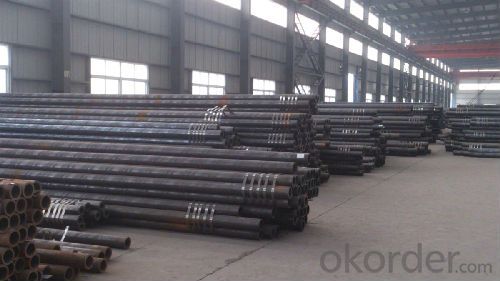
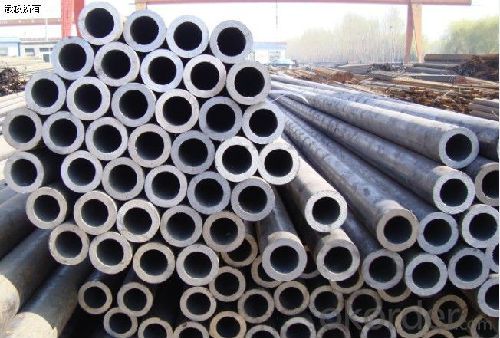
- Q: Stainless steel heating oven tube after treatment is heating blue will not be red?
- When the power is not enough, his argument is clearly untenable, and technology is a kind of metal surface treatment. Heating 250 degrees is not red, can not say is not normal, only can meet your work requirements, no problem.
- Q: Can stainless steel pipes be used for sewage applications?
- Yes, stainless steel pipes can be used for sewage applications. Stainless steel is a highly durable and corrosion-resistant material, making it an ideal choice for handling sewage and wastewater. It is resistant to chemicals and other harsh substances commonly found in sewage systems, ensuring long-lasting performance and minimal maintenance. Additionally, stainless steel pipes have smooth interior surfaces, which reduce the likelihood of clogs and blockages caused by debris or build-up. Overall, stainless steel pipes are a reliable and hygienic option for sewage applications.
- Q: What is the external protection used for stainless steel pipes?
- To safeguard stainless steel pipes from corrosion and maintain their integrity, various methods of external protection are employed. One approach involves the application of a protective coating or treatment to shield the pipes and prevent corrosion. Despite stainless steel's inherent resistance to corrosion, it remains vulnerable to certain environmental conditions. A commonly utilized method of external protection entails applying a corrosion-resistant coating, such as epoxy, polyethylene, or zinc. These coatings create a barrier between the stainless steel pipe and its surroundings, preventing direct contact and potential corrosion. Additionally, they serve to safeguard the pipe against physical damage, such as scratches or abrasions, which could lead to corrosion. Another method employed for external protection involves cathodic protection. This technique encompasses either the usage of sacrificial anodes or the application of an electric current to the stainless steel pipe. By sacrificing the anodes or inducing an electrochemical reaction, corrosion is redirected away from the pipe. Furthermore, external protection may include the utilization of insulation materials to prevent condensation and moisture accumulation on the pipe's surface. Moisture can expedite corrosion, and hence proper insulation aids in upholding the stainless steel pipes' integrity. Overall, the aim of external protection for stainless steel pipes is to avert corrosion and ensure their longevity and reliability. By employing various protective coatings, cathodic protection, and insulation, stainless steel pipes can be shielded from environmental factors, thereby guaranteeing optimal performance.
- Q: Can stainless steel pipes be used in food processing industries?
- Yes, stainless steel pipes can be used in food processing industries. Stainless steel is a highly durable and corrosion-resistant material that does not react with food or beverages, making it ideal for use in food processing facilities. It is also easy to clean and maintain, ensuring the safety and hygiene of the food processing process.
- Q: What is the maximum allowable working pressure for stainless steel pipes?
- The maximum allowable working pressure for stainless steel pipes depends on various factors such as the grade of stainless steel, pipe size, wall thickness, and temperature. It is typically determined using industry standards and codes, such as ASME B31.3 for process piping. Therefore, there is no one-size-fits-all answer to this question and it is important to consult the relevant standards and engineering guidelines for accurate and specific information.
- Q: How do you calculate the maximum allowable span for stainless steel pipes?
- The maximum allowable span for stainless steel pipes can be calculated by considering various factors such as the material's tensile strength, the pipe's diameter, wall thickness, and the type of support or loading conditions. By using engineering formulas and standards specific to stainless steel pipes, such as those provided by ASME B31.1 or ASME B31.3, one can determine the maximum span that ensures structural integrity and safety.
- Q: What are the different types of stainless steel pipe end connections?
- Various types of stainless steel pipe end connections are available, each designed to meet specific application and requirement criteria. Some commonly used types include: 1. Threaded connections: These connections have threads on the inside or outside of the pipe end, enabling it to be screwed onto another threaded fitting or pipe. Threaded connections are typically utilized in low-pressure applications. 2. Socket-weld connections: In this connection type, the pipe end is inserted into a socket or recess of a socket-weld fitting and then welded around the outer circumference of the pipe. Socket-weld connections are ideal for high-pressure applications and are renowned for their strength and reliability. 3. Butt-weld connections: Butt-weld connections involve directly welding the pipe end to another pipe or fitting. They are commonly found in high-pressure and high-temperature applications. 4. Flanged connections: These connections have a flange on the pipe end, which is bolted to a mating flange on another pipe or fitting. Flanged connections are used in applications that require easy disassembly or frequent maintenance. 5. Compression connections: Compression connections utilize a compression fitting to join the pipe ends. These connections are often employed in plumbing and gas supply systems due to their ease of installation. 6. Grooved connections: Grooved connections employ grooved couplings to join the pipe ends. These connections are frequently utilized in fire protection systems and are known for their swift and uncomplicated installation. Ultimately, the choice of stainless steel pipe end connection depends on the specific application, pressure requirements, ease of installation, and maintenance considerations. It is essential to consult with a professional or refer to industry standards to determine the most suitable connection type for your particular needs.
- Q: Can stainless steel pipes be used for food storage facilities?
- Yes, stainless steel pipes can be used for food storage facilities. Stainless steel is highly resistant to corrosion, easy to clean, and non-reactive with food, making it a suitable material for ensuring food safety and hygiene in storage facilities.
- Q: What is the lifespan of stainless steel pipes?
- The lifespan of stainless steel pipes can vary depending on various factors such as the grade of stainless steel used, the environment in which they are installed, and the maintenance and care they receive. However, in general, stainless steel pipes have a long lifespan compared to other materials commonly used for piping systems. Stainless steel pipes are known for their durability and corrosion-resistant properties. They are designed to withstand harsh conditions, high temperatures, and various corrosive substances, making them suitable for a wide range of applications. This inherent resistance to corrosion allows stainless steel pipes to have a longer lifespan than pipes made from materials like carbon steel or plastic. In ideal conditions and proper maintenance, stainless steel pipes can last for several decades or even longer. In some cases, stainless steel pipes have been known to last for over 100 years. However, it is important to note that the actual lifespan can vary depending on the specific application and the level of care provided. Regular inspection, maintenance, and cleaning can help extend the lifespan of stainless steel pipes. This includes removing any deposits or buildup that may occur over time, as well as addressing any signs of corrosion or damage promptly. Additionally, choosing the appropriate grade of stainless steel for the intended application can also contribute to a longer lifespan. Overall, stainless steel pipes are known for their durability and longevity. With proper care and maintenance, they can provide reliable and efficient performance for many years, making them a popular choice in various industries and applications.
- Q: What are the common sizes of stainless steel pipes?
- The common sizes of stainless steel pipes vary depending on their intended use and industry standards. However, some of the most common sizes include 1/8 inch, 1/4 inch, 3/8 inch, 1/2 inch, 3/4 inch, 1 inch, 1 1/4 inch, 1 1/2 inch, 2 inch, 2 1/2 inch, 3 inch, 4 inch, 5 inch, 6 inch, 8 inch, 10 inch, 12 inch, 14 inch, 16 inch, 18 inch, 20 inch, 24 inch, and 36 inch. These sizes are typically measured based on the outside diameter (OD) of the pipe. It is important to note that these sizes may vary slightly depending on the specific standards followed by the manufacturer or industry.
Send your message to us
ASME API 5L High Quality Stainless Steel Pipe
- Loading Port:
- Tianjin
- Payment Terms:
- TT or LC
- Min Order Qty:
- 25 m.t.
- Supply Capability:
- 10000 m.t./month
OKorder Service Pledge
OKorder Financial Service
Similar products
Hot products
Hot Searches
Related keywords
